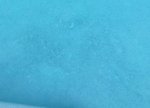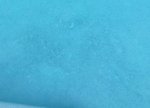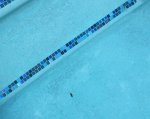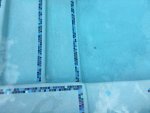Hello,
We have something black on the bottom of the pool that has been getting worse, spreading to almost the whole bottom of the pool, but the pool water is clear looking. We have been using the TFP method of balancing the pool water and have had great success until now. We tried to scratch off a bit of the black stuff from the pool plaster surface in order smear it on a piece of paper to see what color it was but no matter how hard we scratched it, nothing came off on our fingernails and our fingernails broke yet not a thing came off. We also tried brushing it aggressively and not a bit came off on the brush or off the plaster. Also our CC has been between 0 and 0.2 at the very highest. The water looks clear, the black stuff is only on the plaster surface of the pool, not floating in the water as far as we can see.
Could it be black algae if our CC is 0 and the water is clear? If it's not algae, what could it be? Our pool is one year and one month old. We do get a lot of leaf drop from neighbor's tree but we clean out the skimmers daily (they are full daily). We also clean out the inline leaf trap every weekend. And we've been cleaning the filters about twice a month even though it is a large cartridge filter and doesn't need to be cleaned that often. We use the FAS/DPD Chlorine Test in the Taylor K-2006 test kit. The kit is less than a year old and none of the chemicals have expired.
I know our CYA is way too low, but we had high calcium (700) and high salt (4000) so we were going to drain some water and get those to the right level first before adding more CYA. Then we noticed the black stuff on the bottom of the pool and we were going to slam the pool first, but then we realized that the pH and TA were a little low (pH 7.0, TA 40) which was odd as our pH and TA tend to run on the high side. So we added some soda ash (per pool math recommended amount) and drained some pool water (about 15"). The salt is now 2800 (will need to add salt) but the CH was still very high so I brought some water to our pool supply place to see what they said the CH was and they said it was only 380. I checked our CH chemicals in our Taylor test kit and they have not expired and the kit is only about 10 months old. I refilled the R-0010 and the R-0011 anyway. But not the R-0012 as the store did not have it in stock. We keep the test kit indoors. I read some more about CH testing and tried various things to make the test more accurate but it is still about 650-700 according to our test. I generally don't trust pool store testing but they are using the same test kit as we are. The CH test also has lots of little purple specks floating in it which makes me think there is stuff floating in the pool but we just can't see it.
Anyway, CH aside, the soda ash brought the pH up to 7.8 and the TA from 40 to 50. The pH is plenty high now but the TA is still a little low (we want it 60-80) so we bought some baking soda but have not added yet because the black stuff spread so much we decided to slam the pool ASAP. The pool store also said our phosphates are high at 200 which we usually ignore as we follow TFP and our pool is always crystal clear and CC has always been 0 or close to it, but maybe now we shouldn't ignore the phosphate level. The pool store also got a 0 reading for CC.
I know that because our CYA is so low that we have probably not had the correct amount of FC in the pool at all times of the day especially since we only run the SWG at night and because our pool water is so warm and we are in Arizona so the pool gets a ton of sun and we have so much leaf drop. But, if it is black algae, why is the CC so low and why are we not able to scrap the black stuff off at all. I know black algae has a hard waxy/slime coat that requires a metal brush to break through the surface of the algae but wouldn't we be able to scrap some off with our fingernails? Could it not be algae but instead be the plaster is going defective? I know some people have posted about getting black mottling on their plaster quartz finish but if that is what we have why would it not come until over a year after the pool was built and why would it be spreading so rapidly? We do not have grass and have not used any fertilizers so it's not iron.
We did run out and buy bleach today and dumped it in tonight (per pool math amount) but then I read the slamming instructions and realized I need to do this not so late at night when I have more time and I need to buy a lot more bleach as it is more involved then I realized. And we also need to buy a metal stainless steel wire brush since it might be black algae. But then again how can I follow the slamming steps on TFP if our CC is 0? Should I still go ahead and add the baking soda to bring up the TA or wait until after I slam the pool? Any suggestions on how to find our true calcium hardness levels? Should we go ahead and try slamming the pool and if so how do we know when to stop as the CC is 0? Should we add a little CYA now or just go ahead and wait until after we slam the pool?
I know that this is like 10 different posts/questions but as it is all happening at once and I don't know what is pertinent since I don't know what it is or what is causing it, I included it all in one post.
THANKS!!
Levels today (7:00 pm) before adding bleach to slam with our Taylor test kit:
pH 7.8
FC 2
CC 0.2 (somewhere between 0-0.2) (Pool store says CC is 0)
TA 50
CH 600 (my test says 600, pool supply place says 380)
CYA 10
Pool temp: 93 degrees
Pool Store says Phosphates are 200
Salt 2800
It's a SWG pool with plaster quartz finish (QuartzScape super blue by NPT), cartridge filter, acid injector. We use the Taylor K-2006 with the FAS/DPD Chlorine test and AquaChek strips for salt.
We have something black on the bottom of the pool that has been getting worse, spreading to almost the whole bottom of the pool, but the pool water is clear looking. We have been using the TFP method of balancing the pool water and have had great success until now. We tried to scratch off a bit of the black stuff from the pool plaster surface in order smear it on a piece of paper to see what color it was but no matter how hard we scratched it, nothing came off on our fingernails and our fingernails broke yet not a thing came off. We also tried brushing it aggressively and not a bit came off on the brush or off the plaster. Also our CC has been between 0 and 0.2 at the very highest. The water looks clear, the black stuff is only on the plaster surface of the pool, not floating in the water as far as we can see.
Could it be black algae if our CC is 0 and the water is clear? If it's not algae, what could it be? Our pool is one year and one month old. We do get a lot of leaf drop from neighbor's tree but we clean out the skimmers daily (they are full daily). We also clean out the inline leaf trap every weekend. And we've been cleaning the filters about twice a month even though it is a large cartridge filter and doesn't need to be cleaned that often. We use the FAS/DPD Chlorine Test in the Taylor K-2006 test kit. The kit is less than a year old and none of the chemicals have expired.
I know our CYA is way too low, but we had high calcium (700) and high salt (4000) so we were going to drain some water and get those to the right level first before adding more CYA. Then we noticed the black stuff on the bottom of the pool and we were going to slam the pool first, but then we realized that the pH and TA were a little low (pH 7.0, TA 40) which was odd as our pH and TA tend to run on the high side. So we added some soda ash (per pool math recommended amount) and drained some pool water (about 15"). The salt is now 2800 (will need to add salt) but the CH was still very high so I brought some water to our pool supply place to see what they said the CH was and they said it was only 380. I checked our CH chemicals in our Taylor test kit and they have not expired and the kit is only about 10 months old. I refilled the R-0010 and the R-0011 anyway. But not the R-0012 as the store did not have it in stock. We keep the test kit indoors. I read some more about CH testing and tried various things to make the test more accurate but it is still about 650-700 according to our test. I generally don't trust pool store testing but they are using the same test kit as we are. The CH test also has lots of little purple specks floating in it which makes me think there is stuff floating in the pool but we just can't see it.
Anyway, CH aside, the soda ash brought the pH up to 7.8 and the TA from 40 to 50. The pH is plenty high now but the TA is still a little low (we want it 60-80) so we bought some baking soda but have not added yet because the black stuff spread so much we decided to slam the pool ASAP. The pool store also said our phosphates are high at 200 which we usually ignore as we follow TFP and our pool is always crystal clear and CC has always been 0 or close to it, but maybe now we shouldn't ignore the phosphate level. The pool store also got a 0 reading for CC.
I know that because our CYA is so low that we have probably not had the correct amount of FC in the pool at all times of the day especially since we only run the SWG at night and because our pool water is so warm and we are in Arizona so the pool gets a ton of sun and we have so much leaf drop. But, if it is black algae, why is the CC so low and why are we not able to scrap the black stuff off at all. I know black algae has a hard waxy/slime coat that requires a metal brush to break through the surface of the algae but wouldn't we be able to scrap some off with our fingernails? Could it not be algae but instead be the plaster is going defective? I know some people have posted about getting black mottling on their plaster quartz finish but if that is what we have why would it not come until over a year after the pool was built and why would it be spreading so rapidly? We do not have grass and have not used any fertilizers so it's not iron.
We did run out and buy bleach today and dumped it in tonight (per pool math amount) but then I read the slamming instructions and realized I need to do this not so late at night when I have more time and I need to buy a lot more bleach as it is more involved then I realized. And we also need to buy a metal stainless steel wire brush since it might be black algae. But then again how can I follow the slamming steps on TFP if our CC is 0? Should I still go ahead and add the baking soda to bring up the TA or wait until after I slam the pool? Any suggestions on how to find our true calcium hardness levels? Should we go ahead and try slamming the pool and if so how do we know when to stop as the CC is 0? Should we add a little CYA now or just go ahead and wait until after we slam the pool?
I know that this is like 10 different posts/questions but as it is all happening at once and I don't know what is pertinent since I don't know what it is or what is causing it, I included it all in one post.
THANKS!!
Levels today (7:00 pm) before adding bleach to slam with our Taylor test kit:
pH 7.8
FC 2
CC 0.2 (somewhere between 0-0.2) (Pool store says CC is 0)
TA 50
CH 600 (my test says 600, pool supply place says 380)
CYA 10
Pool temp: 93 degrees
Pool Store says Phosphates are 200
Salt 2800
It's a SWG pool with plaster quartz finish (QuartzScape super blue by NPT), cartridge filter, acid injector. We use the Taylor K-2006 with the FAS/DPD Chlorine test and AquaChek strips for salt.





